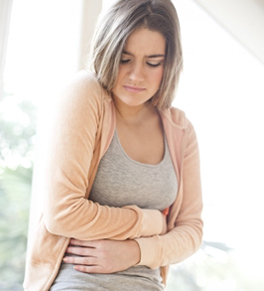Watery Diarrhea Fever Chills Headache Body Aches Back Ache

You're feeling nauseated and your stomach is cramping. You wonder, was it something you ate or a stomach virus?
The constellation of symptoms — nausea, abdominal pain, diarrhea and vomiting — are virtually the same whether the gastrointestinal distress is caused by a virus or a food-borne bacteria.
Doctors say it's hard to pin down the cause by symptoms alone, and most people get better in a day or two without medical intervention.
When people do seek help, "it's because they're vomiting and haven't been able to keep food down for a while or are dehydrated from severe diarrhea," says UCI Health emergency medicine specialist Dr. Shahram Lotfipour. "But it's really hard to know if it's food poisoning or not — unless they come in and say, 'Hey, I just had some bad chicken or bad salad,' or multiple people who ate it came down with the same symptoms."
Food poisoning is caused by bacterial contamination and usually comes on within two to six hours of eating, whereas a viral infection can appear within a few hours or a few days after exposure, according to the National Institutes of Health.
Gastroenteritis and norovirus
Stomach flu is not a flu, which is a respiratory illness caused by influenza viruses. Rather it is a viral infection that attacks the gastrointestinal system.
Viral gastroenteritis is usually caused by one of four types: rotavirus, adenovirus, astrovirus and the caliciviruses, the most common of which is the highly contagious norovirus.
Norovirus can be spread from person to person and by contact with surfaces touched days or weeks earlier by an infected person. It also can be transmitted by food handled by an infected person. In fact, norovirus causes 48 percent of food-borne illness outbreaks compared to 46 percent caused by the usual bacterial culprits — salmonella, E. coli, campylobacter, listeria and staphylococcus — put together, according to the Centers for Disease Control and Infection (CDC).
Related: Checking the spread of norovirus ›
A norovirus outbreak has been implicated in restaurant outbreaks and is frequently found to be the cause of mass illness on cruise ships. Infants, small child and the elderly, especially those in long-term care homes, are particularly vulnerable to norovirus.
Signs of food poisoning vs. a stomach virus
While it is hard to tell the difference between food poisoning and a stomach virus without a test, there are some tell-tale clues, says UCI Health infectious disease expert Dr. Shruti Gohil.
Acute stomach virus infections generally start with:
- Nausea and/or vomiting
- Watery diarrhea
- Abdominal pain or cramping
- Low-grade fever
Sometimes people also experience head and muscle aches as the infection runs its course. Symptoms usually resolve in one to three days, although it may take up to 10 days to completely recover, Gohil says.
Food poisoning, on the other hand, is caused by bacteria and can come on within hours of eating contaminated food. Symptoms include:
- Abdominal pain and cramping that can be severe
- Nausea and vomiting
- Diarrhea
- Fever and chills
If you develop a fever above 101.5 F (38.6 C) and chills, "you should see your doctor immediately," Gohil says. "Some bacteria can be serious and lead to dehydration, kidney failure and arthritis. Depending on the cause, you may need antibiotics."
Most food poisoning bouts clear up with a few days, although some can linger up to 10 days. Related: Should you go to the ER or urgent care? ›
Stay hydrated while the infection runs its course
Whether it is food poisoning or viral gastroenteritis, treatment is essentially the same:
- Ride it out and stay hydrated, says the CDC. Drinking fluids that contain added electrolytes can be beneficial. Untreated dehydration can lead to severe health problems.
- Once you're able to hold food down, gradually add food to your diet. Start with bland foods such as saltine crackers, toast, gelatin, plain yogurt, bananas and fresh apples. Avoid fatty and sugary foods, milk products, caffeine and alcohol until you've completely recovered.
When it's time to see your doctor
A viral stomach ailment is usually accompanied by a low-grade fever and sometimes head and muscle aches. Food poisoning may cause more severe belly pain or cramping.
Gohil recommends seeing a doctor immediately if your symptoms worsen, persist more than a few days or if you experience the following:
- Frequent vomiting, inability to keep liquids down
- Blood in vomit or stools
- Diarrhea lasting more than three days
- Extreme pain or severe abdominal cramping
- Fever above 101.5 F (38.6 C) and chills
- Severe dehydration — excessive thirst, dry mouth, little or no urination, severe weakness, dizziness or lightheadedness
Take precautions to avoid spreading infection
Because viral gastroenteritis is contagious and can stay in the gut up to two weeks after recovery, it is important to avoid spreading the infection, according to the National institute of Diabetes and Digestive and Kidney Diseases, which recommends that patients and their caregivers take the following precautions:
- Wash hands in warm, soapy water for at least 20 to 30 seconds after using the bathroom or changing diapers and before eating or handling food.
- Clean contaminated countertops and other surfaces with a mix of one cup of household bleach to a half-gallon of water.
- Avoid sharing food or drink.
- Stay home from work or school until the illness has run its course.
To prevent future infections, health experts recommend:
- Frequent hand washing
- Thorough cleaning of vegetables and fruit before serving or eating
- Cooking meat thoroughly
Related Stories
- How long is the flu contagious? ›
- What if I can't stay home when I'm sick? ›
- Why bother with a late-season flu shot? ›
Watery Diarrhea Fever Chills Headache Body Aches Back Ache
Source: https://www.ucihealth.org/blog/2016/01/stomach-flu-or-food-poisoning
0 Response to "Watery Diarrhea Fever Chills Headache Body Aches Back Ache"
إرسال تعليق